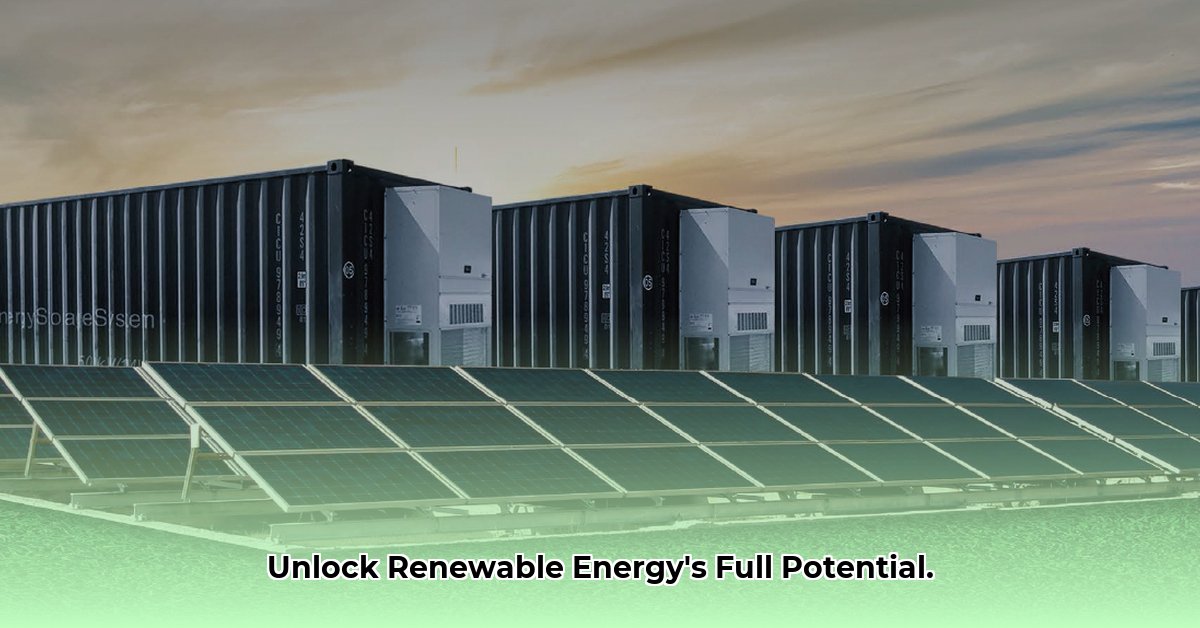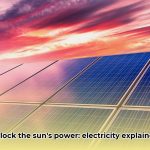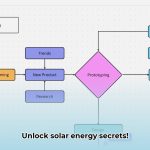Renewable energy sources like solar and wind offer incredible potential, but their intermittent nature presents a challenge. Energy storage is the key to unlocking their full potential, providing a reliable power supply even when the sun isn’t shining or the wind isn’t blowing. This guide explores the various energy storage solutions available, empowering you to make informed decisions about the best option for your needs, whether it’s for your home, business, or the entire power grid.
Powering the Future: Exploring Energy Storage Technologies
Let’s delve into the diverse world of energy storage, examining the technologies that are shaping the future of renewable energy.
Battery Storage: The Versatile Powerhouse
Batteries are the most familiar form of energy storage, powering everything from smartphones to electric vehicles. In the context of renewable energy, they offer a scalable and responsive solution, capable of delivering power almost instantaneously. Lithium-ion batteries currently dominate the market, offering a compelling balance of cost, lifespan, and energy density.
- How it works: Lithium-ion batteries store energy through electrochemical reactions, with lithium ions moving between electrodes during charging and discharging.
- Pros: Adaptable to various scales (residential to grid-scale), high energy density, fast response times.
- Cons: Limited lifespan (typically 5-10 years for Li-ion), cost can be significant for larger installations, some safety concerns (though continually improving).
- Cost Analysis: Varies depending on chemistry and scale, with Li-ion becoming increasingly competitive.
- Applications: Residential, commercial, grid-scale.
- Key Players: Tesla (Powerwall), LG Chem, Panasonic, BYD.
Emerging battery technologies, such as solid-state batteries and flow batteries, hold immense promise. Solid-state batteries, for example, offer potentially higher energy density and improved safety. Flow batteries, on the other hand, excel at long-duration storage, making them suitable for grid-scale applications.
Pumped Hydro Storage: Harnessing Gravity’s Power
Pumped hydro is a well-established technology that utilizes the potential energy of water. It involves two reservoirs at different elevations, with water pumped to the upper reservoir during periods of excess renewable energy generation. When electricity is needed, the water is released back down, driving turbines to generate power.
- How it works: Excess renewable energy powers pumps that move water uphill. When energy is needed, the water flows downhill, spinning turbines connected to generators.
- Pros: Proven reliability, massive storage capacity, long lifespan (50+ years).
- Cons: Geographically constrained, requiring specific topographical features, high upfront capital costs, potential environmental impact on surrounding waterways.
- Cost Analysis: High upfront costs, but low operating costs over its long lifespan.
- Applications: Primarily grid-scale.
- Key Players: Voith Hydro, GE Renewable Energy.
Thermal Energy Storage: Storing Heat and Cold
Thermal energy storage captures and stores heat or cold for later use. This can involve various materials, such as molten salt, water, or phase-change materials. The stored thermal energy can be used directly for heating and cooling applications or to generate electricity.
- How it works: Excess energy heats a storage medium (e.g., molten salt). This heat can then be used directly or to generate steam, which drives a turbine.
- Pros: High efficiency for specific applications (heating/cooling), can utilize waste heat, potentially cost-effective.
- Cons: Less versatile than batteries, thermal losses during storage, can require significant space.
- Cost Analysis: Moderate, depending on the specific technology and materials used.
- Applications: Commercial, industrial, district heating/cooling.
- Key Players: Malta Inc., Nostromo Energy.
Compressed Air Energy Storage (CAES): Power in the Air
CAES stores energy by compressing air into underground caverns or large tanks. When electricity is needed, the compressed air is released, driving turbines to generate power.
- How it works: Air is compressed using excess renewable energy and stored in underground reservoirs. When needed, the compressed air is released to drive a turbine.
- Pros: Scalable, can leverage existing geological formations.
- Cons: Efficiency challenges due to energy loss during compression and expansion, requires suitable geological conditions.
- Cost Analysis: Moderate.
- Applications: Primarily grid-scale.
- Key Players: Hydrostor, Storelectric.
Flywheel Energy Storage: Spinning Reserve
Flywheels store energy as kinetic energy in a rapidly rotating mass. They offer extremely fast response times, making them suitable for grid stabilization and other applications requiring quick bursts of power.
- How it works: A rotor spins at high speed in a vacuum, storing kinetic energy. When energy is needed, the spinning slows down, releasing energy to generate electricity.
- Pros: Lightning-fast response, long operational life.
- Cons: Limited storage capacity, energy loss due to friction.
- Cost Analysis: High.
- Applications: Grid-scale (frequency regulation), niche applications.
- Key Players: Beacon Power, Amber Kinetics.
Hydrogen Storage: A Fuel for the Future?
Hydrogen offers a promising pathway for long-duration energy storage. Renewable energy can be used to produce hydrogen through electrolysis, which can then be stored and used later in fuel cells to generate electricity or for other applications.
- How it works: Electrolysis uses renewable electricity to split water into hydrogen and oxygen. The hydrogen is stored and later used in fuel cells to generate electricity.
- Pros: Long-duration storage potential, versatile applications (transportation, heating, power generation).
- Cons: High costs associated with hydrogen production and storage, requires significant infrastructure development.
- Cost Analysis: Currently high, but expected to decrease with ongoing research and development.
- Applications: Transportation, grid-scale (long duration), industrial processes.
- Key Players: Nel Hydrogen, ITM Power.
Comparing Energy Storage Solutions: A Comprehensive Overview
| Technology | Cost (kWh) | Lifespan | Efficiency | Applications | Pros | Cons |
|---|---|---|---|---|---|---|
| Battery | Varies (Li-ion currently competitive) | Varies (Li-ion typically 5-10 years) | High (85-95%) | Residential, Commercial, Grid-scale | Scalable, Fast response | Cost, Lifespan, some safety concerns |
| Pumped Hydro | High upfront, low operating | Long (50+ years) | High (70-85%) | Grid-scale | Large capacity, Proven technology | Geographic limitations, Potential environmental impact |
| Thermal | Moderate | Varies (depending on material) | Moderate to High (application-dependent) | Commercial, Industrial, District heating/cooling | High efficiency for specific uses, Resourceful | Limited versatility, Thermal loss, Space requirements |
| CAES | Moderate | Long (30+ years) | Moderate (40-70%) | Grid-scale | Large scale potential | Efficiency challenges, Geological requirements |
| Flywheel | High | Long (20+ years) | High (85-95%) | Grid-scale, niche applications | Extremely fast response, Long operational life | Limited capacity, Energy loss due to friction |
| Hydrogen | High | Varies (dependent on storage method) | Moderate (depending on production/conversion) | Transportation, Grid-scale (long duration) | Long-duration potential, Versatile applications | Cost, Infrastructure needs |
The Future of Energy Storage: Innovation and Evolution
The energy storage landscape is constantly evolving. Research and development efforts are focused on improving existing technologies and exploring new frontiers, such as:
- Solid-state batteries: These batteries promise higher energy density, faster charging, and improved safety compared to conventional lithium-ion batteries.
- Advanced flow batteries: Researchers are exploring new chemistries and designs to enhance the performance and reduce the cost of flow batteries for long-duration storage.
- Integratingelectric vehicles as mobile storage units (vehicle-to-grid, or V2G): This approach can potentially increase grid flexibility and provide backup power during outages.
- Artificial intelligence to optimizeenergy storage systems: AI can play a crucial role in managing energy storage resources more efficiently, predicting demand, and maximizing the value of stored energy.
Conclusion: Choosing the Right Solution
Selecting the optimal energy storage solution depends on a range of factors, including your specific needs, location, budget, and desired timescale. This guide has provided a comprehensive overview of the current and emerging technologies, empowering you to navigate the evolving world of energy storage and make informed decisions that contribute to a cleaner, more reliable energy future. While much progress has been made, ongoing research suggests that our understanding of energy storage will continue to evolve, leading to even more effective and sustainable solutions in the future. It’s important to stay informed about the latest developments and consult with experts to determine the best strategy for your specific energy storage requirements.
- How Did Charles F. Brush Discover Wind Energy Tech? - November 19, 2025
- Wind Energy Vertical: Weighing the Pros and Cons of Wind Power - November 16, 2025
- How Much Energy Does a Wind Turbine Actually Create? - November 14, 2025
















